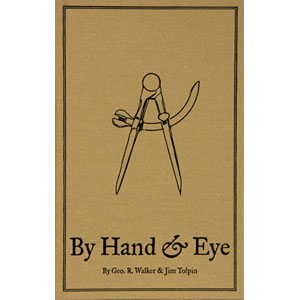
By Hand and Eye, by George R. Walker & Jim Tolpin - Book Review
by J. Norman Reid
Delaplane, VA
This is an important work. The collaboration of one author well-versed in classical design principles and another who's a strong advocate for hand tools and traditional measurement techniques, By Hand & Eye breaks ground that will be new for most woodworkers. The result is an unique combination of theory and practice that is destined to become a classic reference for woodworking design.
This is an engaging work, well-illustrated with color photos and drawings that underscore the book's many messages. But note that I did not say it was an easy read. The authors do their best to render a complex subject simple by breaking it into digestible portions and writing in a clear and entertaining style. However, the subject matter is mind-stretching and, frankly, challenging. And the breadth of the book's scope results in a complex work with many moving parts or, to use the authors' frequent musical analogy, themes and variations.
The book begins gently, with an introduction to measurement without rulers and the importance of the visual elements of design. Drawing on material he published elsewhere, Walker leads an exercise in waking up your eye to the whole number proportions in effective furniture design. He expands this into a discussion of combining simple shapes into more complex and articulated forms. The end result of Section I is an appreciation for the basic elements that comprise furniture design.
Section II, also by Walker, introduces the classic orders of architecture and illustrates their relation to elements in the natural world and ratios built around whole numbers, both themes that run throughout the remainder of the book. These are then related to the furniture design principles of symmetry, contrast and punctuation. At this point, the reader may at times wonder why so much attention is given to Greek architecture and find the plethora of unfamiliar terms confusing. But the careful reader will bear with the authors, for in the end they come full circle to build the classical theory into meaningful practice.
Section III, by Tolpin, makes that conversion. It starts with a helpful review of traditional design and layout instruments—dividers, compasses, sectors, and trammel points, among others—and suggests a tool kit for whole number furniture design. Especially helpful is a discussion of how to use a sector—a largely unfamiliar design tool—and a reference to the web site description of how to make one, since they are unavailable for purchase.
The most valuable part of this section comes next—an extended review of using geometry to create a wide variety of designs. The exercises range from dividing a line into equal segments or ratios, drawing angles, generating squares, rectangles, triangles and polygons to drawing curves, tapers, arches and ellipses, among others. This section makes up a practical reference to techniques that designers will refer to again and again in developing pleasing and wellproportioned creations.
The final section, also by Tolpin, applies the design principles introduced earlier—especially whole number design and the use of human proportions—to nine individual projects. Each piece is designed without reference to any measurement other than the human body or the objects it is intended to hold. Altogether, they provide an opportunity to integrate the book's many themes in forms woodworkers can well appreciate.
Beginning woodworkers may find this book a difficult read, especially if they are concentrating for the present on simpler projects such as jigs and fixtures for the woodshop. But several of the projects in Section IV can be undertaken early in one's woodworking career and beginners who take the trouble to learn these design principles will be better woodworkers from the getgo.
All experienced and serious woodworkers, on the other hand, should not merely own this book but should study its principles and methods, both to better understand effective designs of the past and to derive inspiration and methodologies for improving their future creations. For those of us accustomed to the tape measure and the square, losing our fractions will require some reorientation and new learning. If, like me, your high school geometry is, shall we say, hazy, serious study may be in order.
The book would have been better with a glossary of terms. This would have been especially valuable for the classical architectural elements. Though each term was defined when introduced, by the time I got a page or two further along, I often found I'd forgotten what it was. While my college art history class covered this subject, it is now too many decades removed to be of much help.
In the end, you will want to re-read and study this book to learn the principles and practices it presents. They are destined to enhance both the appeal of your designs and the ease and accuracy with which you render them. I highly recommend it.
Purchase your own copy of
By Hand and Eye
today!
The author is a woodworker, writer and photographer living in Delaplane, Virginia, in the
foothills of the Blue Ridge Mountains with his wife, four cats and a woodshop full of
power and hand tools.
He can be reached by email at
nreid@fcc.net
.
Return to
Wood News
front page


